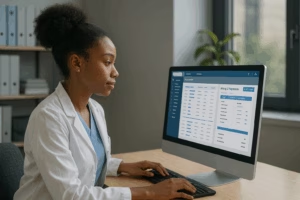Did you know that up to 35% of medical claims contain errors before they ever reach a payer — and that one in five denied claims is never resubmitted?
Those two numbers alone represent millions in lost revenue every year across U.S. healthcare practices.
For many organizations, the problem isn’t lack of effort — it’s lack of visibility.
The revenue cycle has become increasingly fragmented: charge capture happens in one system, coding in another, and collections are often tracked manually or inconsistently. Each handoff introduces risk, delay, and revenue leakage.
As we move toward 2026, where payer automation and data transparency will be the norm, disjointed processes simply won’t keep up. To stay profitable and compliant, you need a unified view — a complete map of your revenue cycle from the moment care is delivered to the moment cash is collected.
That’s exactly where Accelerated Medical Management Solutions (AMEDMS) can help. We partner with COOs and administrators to build connected, measurable RCM frameworks that eliminate gaps, drive accountability, and prepare organizations for what’s coming next.
Why 2026 Readiness Starts with Process Clarity
The rules of reimbursement are shifting quickly.
CMS and major payers are doubling down on interoperability, automated audits, and data accuracy. Practices that can’t provide clean, connected billing data will see slower reimbursements — and potentially increased compliance scrutiny.
“2026 readiness” isn’t about installing a new billing tool. It’s about restructuring how your organization captures, moves, and measures revenue-critical data.
By visualizing your entire revenue cycle as a single process — not separate silos — you can identify exactly where cash flow stalls and where operational friction occurs. That clarity becomes the foundation for efficiency, compliance, and growth.
Visualizing the End-to-End Revenue Cycle
Each step should have a short KPI or note:
- Charge Capture: Ensure all billable services are documented within 24–48 hours.
- Coding & Validation: Maintain error rates below 2% with automated edits.
- Claim Submission: Target first-pass acceptance above 90%.
- Payment Posting: Record remittances within 3 days of receipt.
- Collections: Track recovery rate and AR days under 40.
- Continuous Improvement: Review trends, update workflows, and refine KPIs monthly.
When this process is connected — not pieced together — you gain visibility across your entire revenue stream.
Where Most Organizations Lose Revenue
Even well-established practices often struggle with hidden inefficiencies. Common pain points include:
- Delays between service delivery and charge entry.
- Coding discrepancies that lead to denials.
- Claims sent without pre-authorization or complete documentation.
- Manual payment posting that slows reconciliation.
- Fragmented collection efforts with no unified reporting.
These gaps often go unnoticed until cash flow dips or aging receivables spike.
That’s why AMEDMS starts every engagement with a Revenue Cycle Gap Analysis — a structured review that benchmarks your processes and KPIs against industry best practices.
This analysis identifies where your workflows break down and why revenue is leaking. The outcome is an actionable roadmap that closes those gaps before they impact your bottom line.
Turning KPIs into a Real-Time Financial Dashboard
Data only matters when it’s visible, accurate, and actionable.
At AMEDMS, we transform your raw metrics into a clear dashboard that tracks the health of your revenue cycle in real time.
Key metrics include:
- Charge Capture Lag — The time between service and billing.
- Denial Rate — A true indicator of process quality.
- Clean Claim Rate — A measure of accuracy at submission.
- Days in AR — Your cash flow velocity.
- Net Collection Ratio — Your ultimate performance score.
When these KPIs are standardized and aligned across departments, you don’t just react to financial problems — you anticipate them.
Our analytics tools give administrators the transparency to see trends early, act decisively, and measure the ROI of every operational improvement.
Preparing for the Age of Automation and Integration
By 2026, the most successful healthcare organizations will be those that integrate automation, analytics, and accountability across their entire RCM ecosystem.
Manual handoffs and disconnected systems won’t survive the shift to data-driven reimbursement.
AMEDMS helps practices modernize their RCM infrastructure by:
- Automating charge capture and validation to eliminate human error.
- Integrating EHR and billing systems for seamless data flow.
- Building compliance checkpoints that meet evolving payer standards.
- Using AI insights to predict denials before they happen.
This forward-thinking framework not only safeguards compliance — it accelerates collections and frees your team to focus on patient care instead of paperwork.
A Partnership Built on Clarity and Control
At AMEDMS, we believe your revenue cycle should never feel like a black box.
You deserve transparency, measurable outcomes, and a partner that helps you continuously improve performance.
Our approach is collaborative and data-driven — designed to align your people, processes, and platforms around one goal: capturing every dollar you earn, faster and more efficiently.
Whether you manage a growing specialty practice or a multi-site healthcare group, we’ll help you identify hidden gaps, streamline handoffs, and build the financial readiness your organization needs to thrive in 2026 and beyond.
Request Your Complimentary RCM Gap Analysis
Take the first step toward a stronger, more connected revenue cycle.
Request a complimentary RCM Gap Analysis from AMEDMS today and receive:
- A visual map of your current charge-to-collection process.
- A KPI performance summary benchmarked against industry leaders.
- A personalized action plan for improving cash flow and operational efficiency.
Your data tells a story — we’ll help you read it, refine it, and turn it into measurable results.
👉 Request your RCM Gap Analysis now and start building a 2026-ready revenue cycle with AMEDMS.



